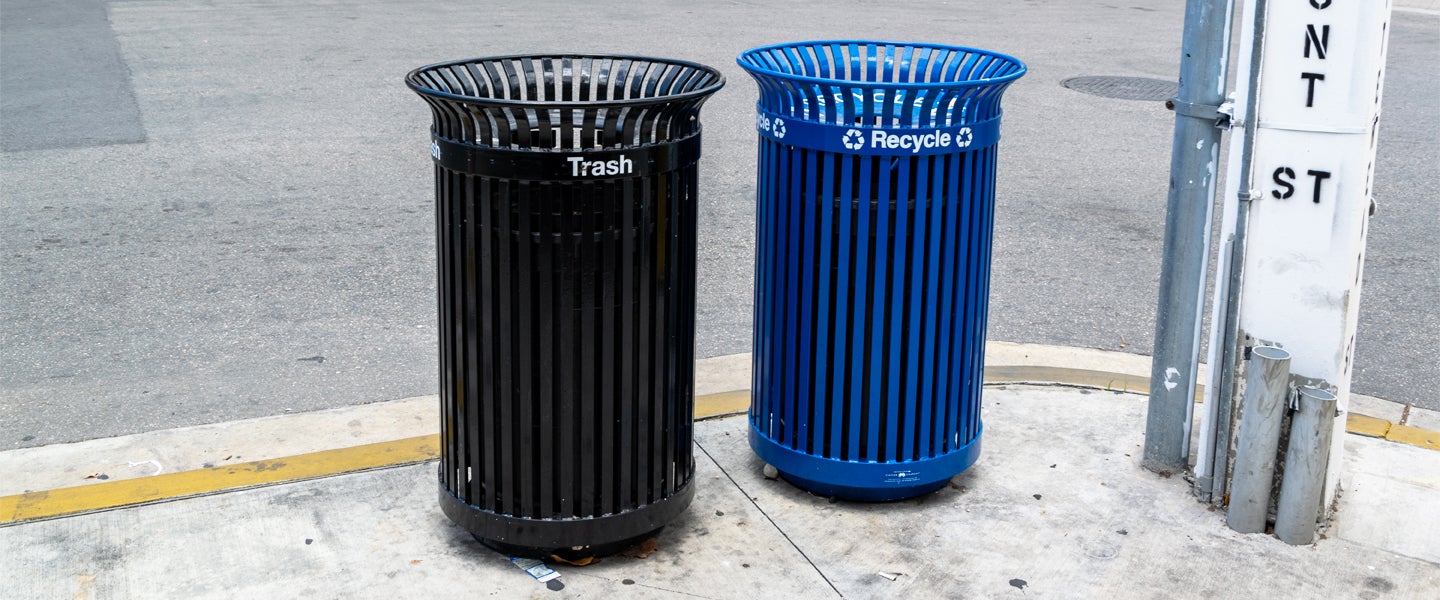You’re just a regular person, simply trying to Do Your Part™ to prevent the planet from roasting your future grandchildren alive. So you dutifully rinse out your Jamie Lee Curtis-approved Activia yogurt cups before you recycle them. You politely call AT&T to request that they stop sending you promotional mail. But [Morpheus voice] what if I told you… recycling isn’t real?
Okay, it’s still real in the sense that processes exist to turn the packaging of a drunken Amazon purchase into playground equipment. Some Fiji Water bottles will miraculously become an Everlane sweatshirt. But increasingly, the stuff we shove in our recycling bins isn’t actually being turned into anything else. Instead, it sits in warehouses, waiting to be made anew. Otherwise, it’s unceremoniously dumped in a landfill.

One major problem is capitalism. Recycling only occurs to the extent that it’s profitable to do so, explains CalRecycles Public Information Officer Lance Klug. “Technically, you can recycle anything. You can recycle Styrofoam, but is anyone going to pay you the money for that Styrofoam to make new products? Probably not.”
For decades, though, China was willing to pay us for our blue-bin items, taking at least 50 percent of our plastic recycling. Chinese ships would arrive here filled with consumer goods, and we’d send them back with our bottles and junk mail. Eventually, our waste would be turned into iPhone cases and traffic cones. In the United States, aluminum, glass and certain paper products continued to be valuable recyclable commodities that could be processed within the country. Because China dominated plastic recycling, though, we never developed the proper infrastructure to reuse plastics here.
But at the beginning of 2018, China decided that not only did the nation already have enough of its own products to recycle but that the recyclables they received from the United States weren’t worth the labor. As accomplished as we felt after rinsing out that container of salsa we let sit in the back of the fridge for three months, our recyclables were still too dirty, eating up processing centers’ resources and polluting the air, land and water. For China, accepting paper and plastic from other countries created another environmental problem in trying to solve one.

China hasn’t stopped taking our plastics and papers entirely. They’ll still accept plastics that are 99.5 percent uncontaminated. Unfortunately, according to Klug, American recycling is usually at least 25 percent contaminated.
Now, across the country, towns are scrambling trying to figure out what to do with the stuff that China would have previously paid for and cleaned up. Without the option of shipping it to China, some towns are simply tossing plastic in the landfill, having it incinerated or turning to other recycling markets in Southeast Asia. Towns like Hancock, Maine, have ceased their recycling programs indefinitely. As NPR reported in episode 926 of Planet Money, while citizens may still be dutifully sorting their plastics from the rest of their trash, in towns like Nogales, Arizona, it just ends up in the same place. In Nogales, recycling one ton of plastic would cost $200, whereas burying that plastic costs $30.
But even in the years when China did take our waste, recycling still wasn’t necessarily the best thing for the planet. Take, for example, a jar of peanut butter: The amount of hot water required to adequately clean this sticky plastic outweighs the environmental benefit of attempting to recycle it. More than that, the jar needed to be transported across the world by gas-fueled trucks, trains and boats. By the time it was transformed into a fresh pair of tube socks, the earth had endured the same beating it would have taken if those socks were made from new material. In some cases, it’s actually better for the planet for plastic to end up in a landfill rather than make a journey across the globe.

We’ve been wrong to pat ourselves on the back just for recycling. According to Planet Money, many of the plastics sent to China ended up in the ocean, where it could kill marine life and will never decompose. So rather than simply emphasizing recycling, says Klug, we need to be thinking more about using less disposable plastic in the first place. That means buying less heavily packaged items — and also holding manufacturers responsible for their production.
That’s all pretty depressing. But don’t let it deter you from your planet-friendly habits. Despite it all, you should still recycle. “Recycling reduces the need to mine new raw materials, petroleum, drilling for new oil,” says Klug. That said, both our consumer and manufacturing practices need to be overhauled in order to “make sure recycling fits in our current landscape a bit better,” he adds.
Klug recommends two things: 1) that everyone get a better understanding of their town’s recycling regulations, and 2) be more careful about properly cleaning your plastics. Hopefully, the United States will eventually develop the right infrastructure to make plastic recycling feasible on a local level. Until then, the best thing you can do for the planet is to simply buy less trash. Carrying around a reusable coffee mug or canvas tote might seem obnoxious, but, like, grow up, you know?


